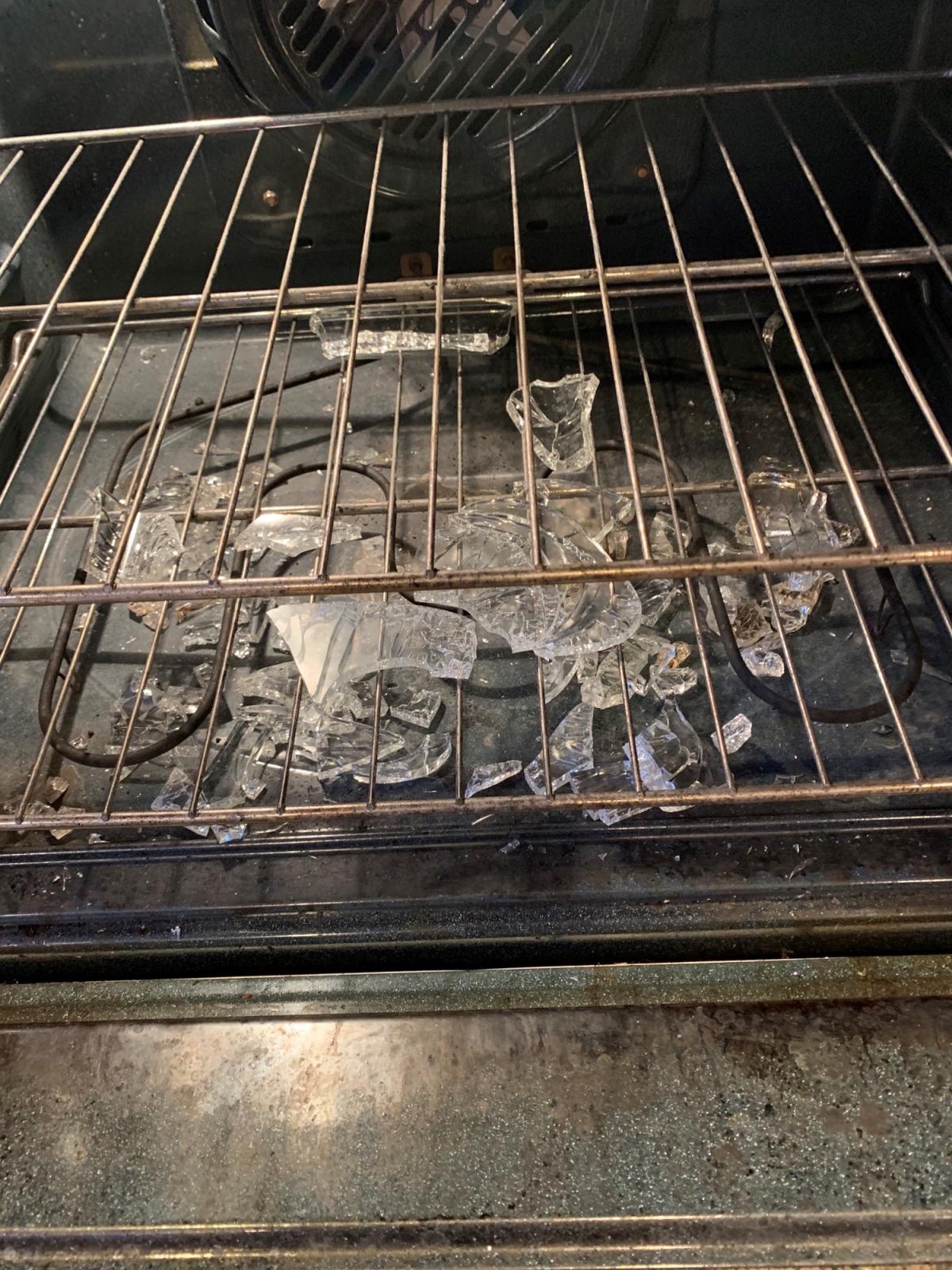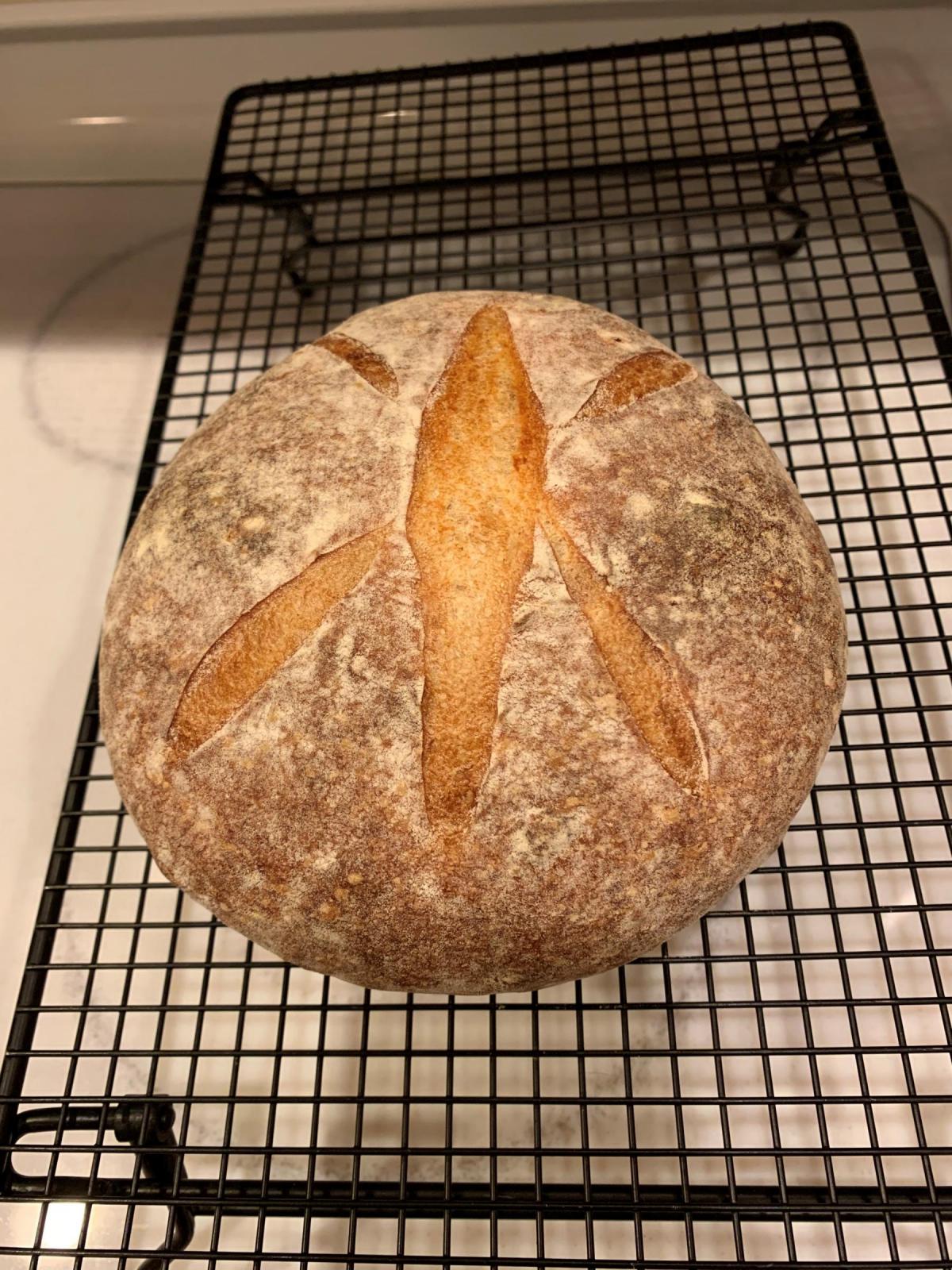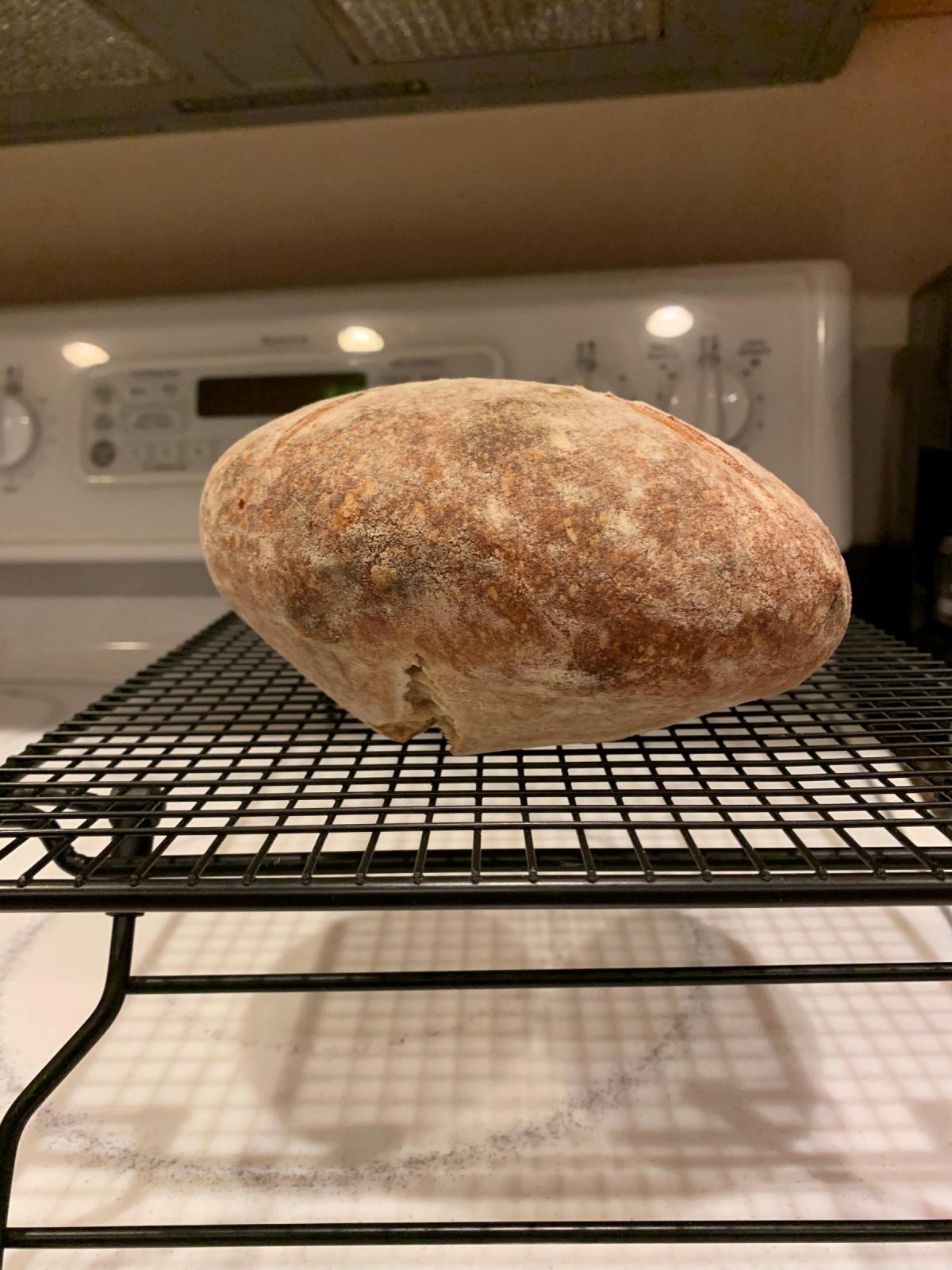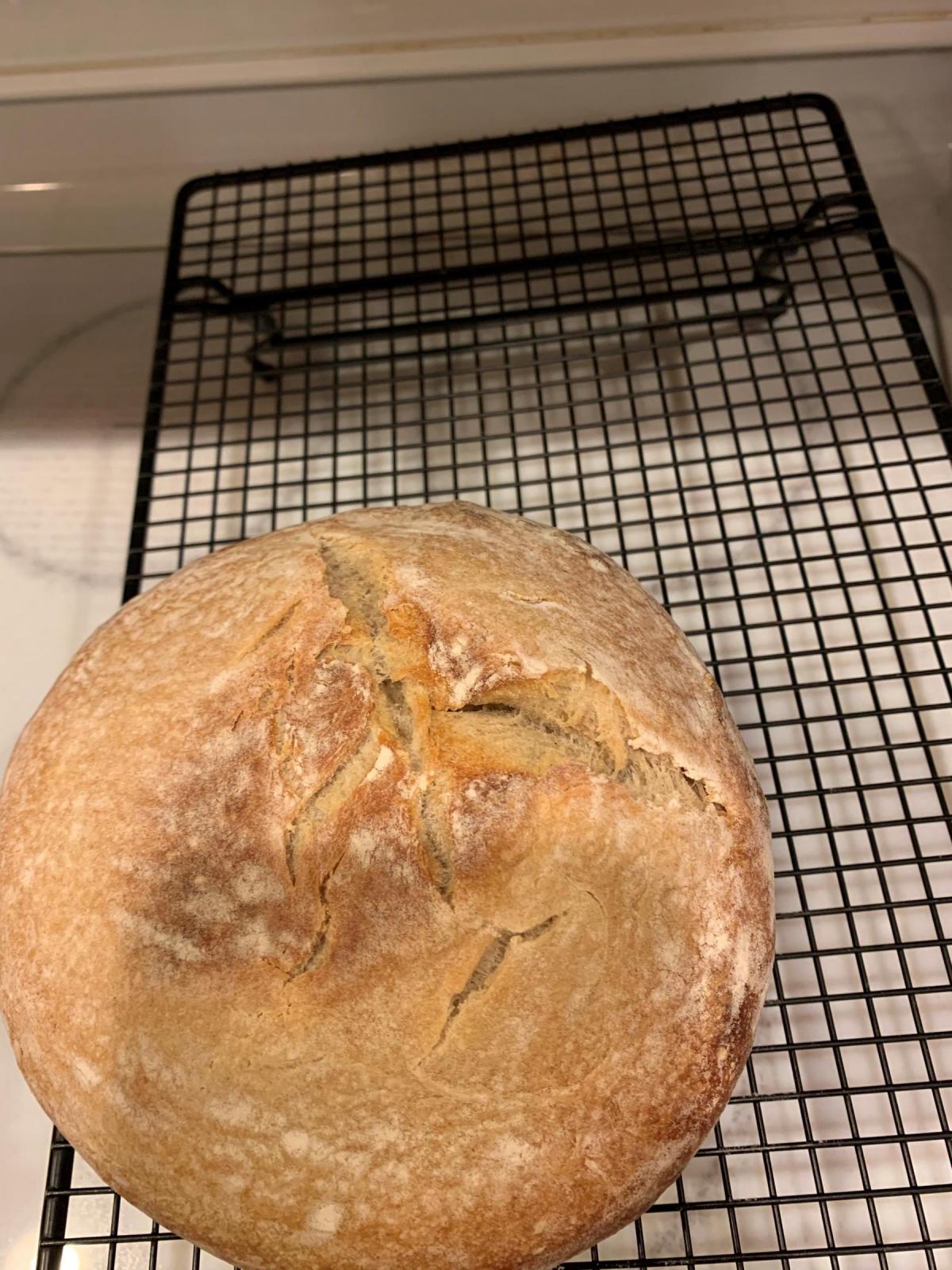Baked my second SD loaf today and had a couple newbie learning experiences...
The Salt Does Matter
Recipe called for a 30 minute autolyse followed by 6-8 minutes of hand kneading. Got to the end of the autolyse and started kneading. Dough never started to stiffen and stayed quite sticky. At the end of 8 minutes, I was telling myself that my kneading technique sucked and it was time to watch more videos. Went back and looked at the recipe and saw that one little detail... Add 16g of salt between autolyse and kneading. Added the salt as evenly as I could at that point and kneaded for another 3-4 minutes until I got window panes. Amazing what missing an ingredient can do! Not sure how that impacted the final loaf qualities.
I Like Using a Baking Stone but a Pyrex Baking Dish Makes a Terrible Water Pot
I have a large pizza baking stone that I used on my first loaf. Don't have a Dutch Oven. I used a cookie sheet for the water pan on that first one, but didn't put much water in to avoid overflowing. Saw a video where they used a porcelain type baking dish for the water pot below the stone and thought it was a great improvement over my cookie sheet. Didn't have a porcelain dish, but had a glass Pyrex dish. Preheated to 450 deg F (my oven runs a little hot) and had the loaf scored and on the stone. Dumped some boiling water into the dish and immediately found out why that was a terrible idea. The minute it happened I told my self "Duh! You should have known that!" along with many other choice words. It shattered... Had to dig glass out of the oven door so I could close it. Quickly grabbed a cookie sheet, layed it on top of the shattered glass, and put some now below boiling water in it. Closed up the oven (which was now well below 450 degrees) and hoped for the best.

Despite all that, I was much happier with this loaf than my first. It held it's shape much better and wasn't a frisbee. Not sure I got much of an oven spring, the crust was not crunchy at all, and I had a slight blow out on the bottom, but overall, it looks good from the outside. Haven't cut into it yet to see what the crumb looks like.
A couple of questions...
What is the typical size of a loaf that uses 400g of flour?
I used the beginner Vermont Sourdough recipe that calls for a total of 790g of flour (710g bread, 80g rye) and split it (2nd loaf is in the refrigerator and will get baked tomorrow). Even though the loaf held its shape nicely, I don't think I got much (if any) rise during the final proof. Not sure how much the lost oven spring would have helped with loaf volume, or how much adding the salt late impacted the rise. This loaf measures just over 6" in diameter and about 3.5" tall in the middle. It's a nice little loaf, but seems small compared to pictures I see. Just wondering if I didn't get the rise I should have during final proofing.
Baking a loaf after being in a refrigerator?
After the Pyrex dish debacle, my plans for baking the second loaf were put on hold. I put it in the refrigerator after final proofing and plan to bake it tomorrow. Can I go straight from the refrigerator to the oven, or do I need to let it come to room temp before baking?
Thanks in advance for any help, and I hope other newbies learn from these mistakes! :-)



To address the last question, bake directly from the fridge (don't forget to score though - and scoring cold dough is much easier).
For the blow-out - do you have convection on when you bake?
Shame about the pyrex bowl! I used one instead of a Dutch oven if baking just one loaf and it works great.
I had the convection on during oven pre-heat, but turned it off when the loaf went in to keep the steam around the loaf and try to get a good oven spring.
What about top heat then?
I watched a video where a guy placed a large cookie sheet on the top rack to create a "chamber" that helped keep the steam around the loaf. But... That does block any radiant heat from the top heating element. Didn't think about that... I did remove that sheet and the cookie sheet with water in it after the first 15 minutes.
If you can't just switch off the top heat, that's the way to go - place a large tray/sheet above the loaf.
Was your steaming tray above or below the loaf?
Below the loaf
Right. I also keep it below, but I switch of the top heat just before loading the loafs. If you can't switch it off in your oven, put in a tray in the top of the oven.
Does the dough continue to ferment in the refrigerator after final proofing, or does the low temperature slow it down to a point where not much happens? It will be about 24 hours in the refrigerator.
It takes a while to cool down to the fridge temperature and definitely continues fermenting until then. After it's cold it depends on the fridge temp. I think it's usually quoted that above 4C it still continues fermenting just slowly, and below 4C it virtually stops.
Thanks a bunch! Curious to see how the flavor of the two compare.
Oh that looks nice actually! Uniform crumb, I don't see any dense parts, and looks like good oven spring?
Only my 2nd SD loaf, so to be honest, I’m not sure I could tell you the difference between good and poor oven spring. I just know that my first loaf was flat on edges with a mound in the middle and this one has a more uniform shape.
Good to know on the crumb! It’s not open and airy, so I thought that equals “dense”. It is uniform in size. Still learning the vocabulary. ?
Yeah, some people like open crumb with huge holes, others don't like jam dripping through and prefer a closed crumb. It's a personal preference. Controlling it and achieving on or the other on purpose - that's the more tricky part though, I have not mastered that yet!
So my question on loaf size is kind of irrelevant because it depends on open versus closed crumb with a more open crumb being a bigger loaf?
Just trying to determine if my starter is where it needs to be and if I’m getting a proper rise.
Interesting question, I am not sure that's true, but maybe someone else will chime in. I don't think size in a baked loaf is a good indicator of fermentation activity. You can get huge oven spring with underproofed bread. Rise during bulk ferment and final proof is more relevant, I'd say.
Starter is working, how well would be the question. Well as in - strong enough to do what you want with the timings used.
On the loaf, how does it feel? If it feels heavy, it's probably dense. If it feels light, it isn't.
As, to me, it looks heavy, you might want to give more proofing time. To keep the crumb nice and even (desirable for me), try a quick knead after the dough has risen 2x (each time it rises 2x). Enjoy!
Oh - salt - yeah it helps the dough. And - once you taste bread without salt, you'll never forget it again. Salt is one of those better a little too much than too little things.
Not boat anchor heavy, but yes, I think heavy is a good description.
The recipe called for bulk fermenting at “room” temperature for 2.5 hours with folds every 50 minutes. My room temperature was 73 degrees. Sound about right? I don’t know that I achieved a 2x rise between folds.
Well, like real Vermonters used to say - hard telling not knowing ie not knowing your starter and flour amongst other things, hard telling. Except, if it's heavy, get more air into it. If the flavor is what your looking for, "fermentation" is probably ok - what to try next should be easy. Enjoy!
As I got to the center of the loaf, the crumb became much less uniform and less airy. Couldn't see any open crumb in a few portions.
Flavor is not too bad. Waiting to try the loaf I baked yesterday that spent roughly 24 hours in the fridge to see if there's any difference. Had the same bottom blowout on that one and similar feel to the loaf, so guessing I will find the same crumb when I slice into it.
Learning more with each one! :-)
May I ask what your oven setup is? The reason I ask is that from the looks of your loaf there is too much heat happening up top and not enough down below. The bottom crust is surprisingly pale and I’m guessing from the shape of the loaf that the top of the crust set up too soon and since the bottom wasn’t getting enough heat expansion then happened in the bottom half of the loaf lifting the bottom edges off the baking surface.
Is your top element firing when you’re baking?
What rack are you baking on? Is there something shielding the bottom of the baking surface from the heat below?
Sorry if I missed something in the discussion in the thread already.
Benny
Benny,
No worries and I appreciate any and all help in shortening my learning curve. :-) Ask away!
I have a GE Profile oven with a heating element on the top and bottom. I can't turn off the top element (that I'm aware of anyway).
I have it arranged like this while baking...
Bottom rack roughly 4.5" above bottom element. This is where I put the water pot.
Middle rack is two positions up from that. It is roughly 9" above bottom element and 8.5" below top element. This is where I have my pizza stone that I bake the bread on.
Top rack is on the top position and is roughly 5.5" above the bread rack. I place a large cookie sheet on that to help create a steam "chamber" and I guess it does help shield the bread from the top element.
I set my oven to 475 degrees with the pizza stone, top cookie sheet, and water pan in the oven. Convection going. When it gets to 475 degrees, I turn the convection off, put the loaf on the stone (use parchment paper to transfer it) and pour boiling water in the pan. Oven takes maybe 20 minutes to preheat.
Cook for 15 minutes with water pot in the oven. Take it out and remove the top cookie sheet for the last 15-20 minutes.
Thanks for any insight or help!
You might want to try this next time, bake your bread on the baking stone on the lowest rack, that will get more heat into the bottom of the dough which is where you want it for most if not all of your bake. They will give you better oven spring. Your steam can go above the bread, it will still steam your bread. By baking your bread lower the top of the dough will also be further from the upper element.
Now, open your owners manual of your oven, see if there is a setting you can bake at that doesn’t activate the upper element. If there is too much heat from above you’ll set the crust way too early and you’ll never get the results you want. Now, every if you cannot turn it off putting the steam set up above the bread will act as a heat shield as well, water in a tray will block a lot of the radiant heat from that upper element. But still it would be better to have that upper element off.
Now you didn’t mention convection, if you have a fan/convection setting, turn it off during the steam portion of your bake, you can turn it on later but not during the steam portion. I think I’ve read that some ovens will vent more of the steam if the convection is on.
Thanks for the tips and will try them the next time I bake.
I just looked at the second loaf I did yesterday, and you're right... The bottom is very pale compared to the top.
I also just thought of this when you mentioned bottom heat, which is kind of what I thought the stone was there to do. Do you think I'm not getting the stone up to temp by putting the bread in as soon as my oven gets to temp? Maybe a longer pre-heat?
So get that stone on the bottom rack, crank your oven up to 500ºF for the pre-heat. Wait 10-15 mins after it has reached temp before you load your bread. It takes a while longer for the metal and the stone to reach 500ºF after the air temp is 500ºF. Load the dough, then get that water in the pan above the bread. Turn off the convection and drop the temperature to 450ºF or so to bake.
Thanks!